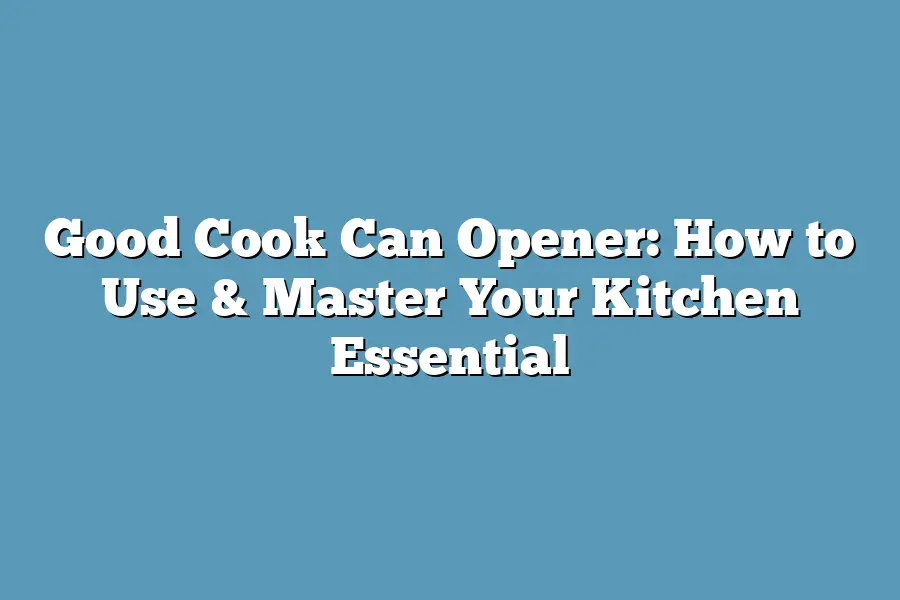A good cook can open a can in several ways, but one of the most common methods is by using a manual or electric can opener. To use a manual can opener, place the device on the edge of the can and turn the handle until the opener punctures the top of the can. Then, continue turning the handle to cut around the top of the can, creating an opening that allows you to pour out the contents. Electric can openers work similarly, but with the added convenience of not requiring manual effort.
I’m excited to share my passion for cooking with you, but before we dive into any recipes, let me ask you a question: are you getting the most out of your kitchen essential – the Good Cook Can Opener?
As someone who’s spent years perfecting their culinary skills in the kitchen, I’ve come to realize that having the right tools can make all the difference between a mediocre meal and a masterpiece.
And when it comes to opening cans, it’s not just about getting the job done quickly and efficiently – it’s also about ensuring your safety and the quality of your cooking.
In this post, I’ll be sharing my expert tips on how to master your Good Cook Can Opener, from choosing the right one for your needs to advanced techniques for opening different types of cans.
Whether you’re a seasoned chef or just starting out in the kitchen, this guide will help you unlock the full potential of your can opener and take your cooking to the next level.
Table of Contents
Step 1: Preparing Your Can Opener
As a self-proclaimed kitchen enthusiast, I’ve learned that having the right tools for the job is essential.
And let me tell you, my friends, there’s nothing more frustrating than struggling with a can opener that just won’t cooperate.
That’s why today, we’re going to dive into the world of can openers and explore how to choose the perfect one for your needs.
Choosing the Right Can Opener: What to Look Out For
When it comes to selecting the ideal can opener, there are a few key features you should keep in mind.
First and foremost, ease of use is crucial.
You want an opener that’s going to make quick work of even the most stubborn cans, without leaving you feeling frustrated or exhausted.
Durability is also a must – after all, you don’t want your can opener breaking on you in the middle of meal prep.
But what about manual vs electric?
This is where things get interesting.
Manual openers are great for those who like to keep things simple and don’t mind putting in a little extra elbow grease.
They’re also often more affordable than their electric counterparts, making them a great option for budget-conscious cooks.
On the other hand, electric openers offer a level of convenience that’s hard to beat – just place your can on the device, press a button, and voila!
Your food is ready to be devoured.
So how do you decide which type of opener is right for you?
It really comes down to personal preference and your cooking style.
If you’re the type who likes to take their time and enjoy the process, a manual opener might be the way to go.
But if you’re short on time or have a lot of cans to open at once, an electric opener could be your new best friend.
Avoiding Common Can Opener Mistakes
Now that we’ve covered how to choose the perfect can opener, let’s talk about some common mistakes people make when using them.
One of the most critical errors is not following proper usage guidelines.
This might seem obvious, but trust me – it’s easy to get complacent and start relying on muscle memory instead of paying attention to the instructions.
Using your can opener incorrectly can lead to a host of problems, from scratched or damaged surfaces to actual injuries.
And let’s be real – no one wants to risk ruining their favorite kitchen gadget (or worse, their fingers!) by using it improperly.
So what’s the takeaway here?
Simply put, take the time to read and follow the instructions for your can opener.
It might seem tedious, but trust me – it’s worth it in the long run.
And there you have it – my comprehensive guide to choosing and mastering your kitchen essential: the humble can opener.
With these tips and tricks under your belt, you’ll be well on your way to becoming a can-opening master (or mistress, or non-binary individual – I’m not here to judge!).
Happy cooking!
Step 2: Opening Your First Can
You’ve got your Good Cook Can Opener, and you’re ready to tackle that stack of cans in your kitchen.
But before you start cooking up a storm, let’s make sure you’re opening those cans like a pro.
In this section, we’ll walk you through the step-by-step process of using your can opener, plus some troubleshooting tips for when things don’t go exactly as planned.
The Right Way to Open Your First Can
Opening a can with your Good Cook Can Opener is easier than you might think!
Just follow these simple steps:
- Place the opener on the lid: Position the opener on top of the can lid, making sure it’s centered and even.
- Turn clockwise: Slowly turn the handle clockwise until the opener pierces the lid. You’ll know it’s working when you start to hear a gentle hissing sound – that’s your sign that the can is opening!
- Continue turning: Keep turning the handle until the lid is completely removed. Voilà! Your can is now open and ready for cooking.
Troubleshooting Common Issues
Even the best of us can encounter hiccups when using our can opener.
Don’t worry, we’ve got you covered with some quick-fix tips:
- Stuck opener: If your opener gets stuck on the lid, don’t force it! Try wiggling the opener back and forth gently until it releases.
- Lid doesn’t come off: Sometimes, the lid might not come off easily. Try running a knife or sharp object around the edge of the lid to loosen it.
Safety First: Handling Your Can Opener Like a Pro
Remember, safety always comes first when using your can opener!
Here are some crucial precautions to take:
- Handle with care: Always hold the can opener firmly and avoid dropping it, as this could cause accidents or damage.
- Keep children away: Store your can opener in a safe place where children can’t access it. You wouldn’t want any little hands getting hurt!
- Clean up: After each use, wash your can opener with soap and water to prevent rust and bacteria buildup.
By following these simple steps and taking the necessary precautions, you’ll be well on your way to becoming a master of opening cans with your Good Cook Can Opener.
Happy cooking!
Mastering Your Can Opener: Tips and Tricks
As a self-proclaimed kitchen wizard, I’m excited to share my secrets for mastering the humble can opener.
It may seem like a simple tool, but trust me, it’s an essential component in any cooking arsenal.
In this section, we’ll dive into advanced techniques for opening different types of cans, as well as the importance of keeping your can opener squeaky clean and well-maintained.
Advanced Techniques: Opening Pop-Tops and Pull-Tab Cans
I’m sure you’ve encountered those pesky pop-top cans that seem to defy all logic.
You know, the ones where the lid doesn’t quite come off with a simple twist of the wrist?
Yeah, I’ve been there too!
The solution lies in applying gentle yet firm pressure, almost like massaging the can opener’s soul (okay, maybe not that dramatic, but you get the idea).
Start by positioning your can opener at an angle, allowing it to pierce the pop-top lid.
Then, slowly and deliberately rotate the opener until the lid yields to its might.
As for pull-tab cans, they’re a different beast altogether.
These cleverly designed containers require a bit more finesse to open.
To master the art of opening pull-tab cans, follow these steps:
- Find the sweet spot: Locate the small indentation on the can’s edge, just above the tab. This is where your can opener will do its magic.
- Position the opener: Place the blade of your trusty can opener in the indentation and gently rotate it until it starts to pierce the metal.
- Apply gentle pressure: Continue rotating the opener while applying a small amount of downward pressure. The pull-tab should start to separate from the can, allowing you to simply lift it off.
Cleaning Tips and Tricks
Now that we’ve conquered various types of cans, let’s talk about keeping your can opener in top shape.
A clean can opener is not only more efficient but also crucial for longevity.
Here are some quick cleaning tips to get you started:
- Soak it: Fill a bowl with warm water and add a splash of dish soap. Submerge the can opener and let it soak for about 15 minutes.
- Scrub away: Use a soft-bristled brush or a non-abrasive scrubber to gently remove any stubborn debris.
- Rinse thoroughly: Rinse the can opener under running water, making sure to remove any remaining soap residue.
Why is regular maintenance important?
Well, my friends, it’s simple: a well-maintained can opener will last longer and perform better.
A dirty or neglected can opener can lead to reduced performance, rust, and even breakage – not exactly what you want when you’re in the middle of cooking up a storm!
In conclusion, mastering your can opener is all about technique, maintenance, and a dash of creativity.
By following these tips and tricks, you’ll be well on your way to becoming a can-opening virtuoso.
Happy cooking!
Final Thoughts
As I wrap up this guide on mastering your Good Cook Can Opener, I’m reminded of all the times I’ve struggled with stubborn cans in my own kitchen.
But with these simple steps and expert tips, you’ll be a can-opening pro in no time!
Whether you’re whipping up a quick weeknight dinner or preparing for a big batch cooking session, having the right tools (and knowing how to use them) is key.
By following the guidelines outlined here, you’ll not only open cans like a breeze but also ensure your safety and confidence in the kitchen.
So go ahead, grab that can opener, and start cooking up a storm – your taste buds (and your dinner guests) will thank you!


